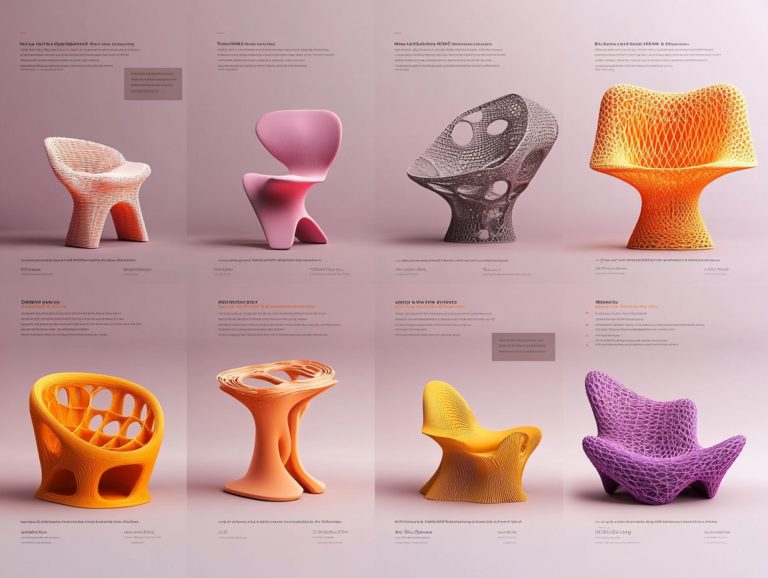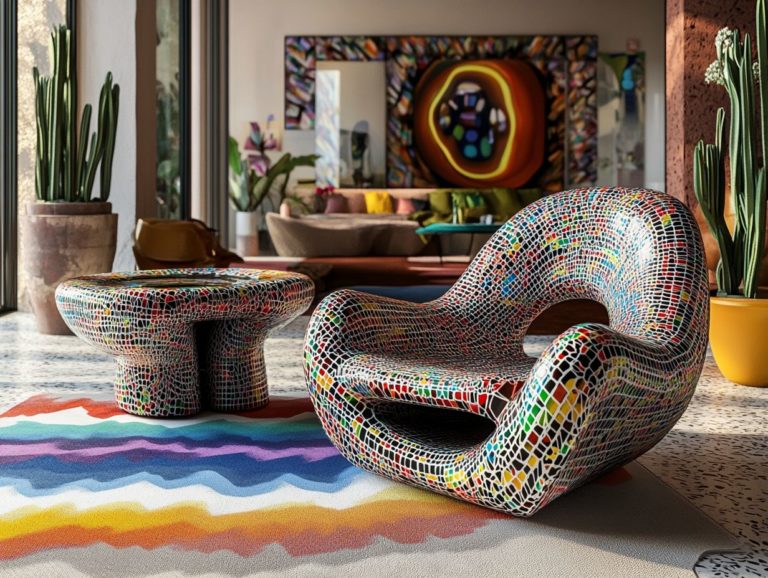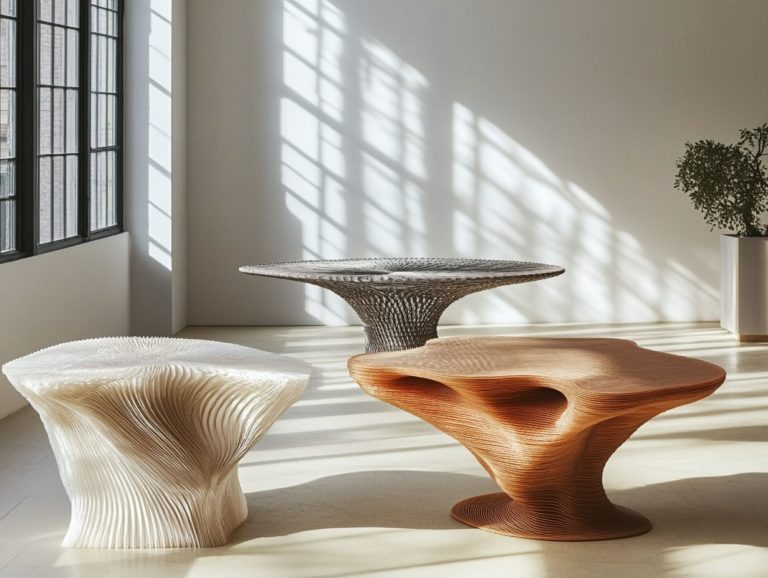5 Unique 3D-Printed Furniture Items You Didn’t Know About
In a world where personalization and innovation reign supreme, 3D printing is revolutionizing the furniture industry before your very eyes!
Picture a chair meticulously sculpted to embrace your unique body shape or a table that wirelessly charges your devices how convenient is that? From adaptable bookshelves to stylish lamps and versatile planters, 3D-printed furniture opens the door to thrilling possibilities where functionality meets creativity.
This exploration covers five exceptional items that highlight 3D printing s incredible potential. You ll discover insights into the materials used, the advantages and limitations of this technology, and the trends shaping its future!
Prepare to witness how this innovation is transforming your living spaces into something truly extraordinary!
Contents
- Key Takeaways:
- 1. 3D-Printed Chair That Can Be Customized to Fit Your Body
- 2. 3D-Printed Table with Built-In Wireless Charging
- 3. 3D-Printed Bookshelf That Can Be Expanded or Contracted
- 4. 3D-Printed Lamp with Interchangeable Designs
- 5. 3D-Printed Planters That Can Be Hung or Stacked
- What Is 3D Printing and How Does It Work?
- What Materials Can Be Used for 3D Printing Furniture?
- What Are the Advantages of 3D-Printed Furniture?
- What Are the Limitations of 3D-Printed Furniture?
- How Can One Purchase 3D-Printed Furniture?
- What Is the Future of 3D-Printed Furniture?
- Frequently Asked Questions
- What are 3D-printed furniture items?
- What are the benefits of 3D-printed furniture items?
- How are 3D-printed furniture items created?
- What are some unique 3D-printed furniture items?
- Can 3D-printed furniture items be used for everyday use?
- Are there limitations to 3D-printed furniture items?
Key Takeaways:
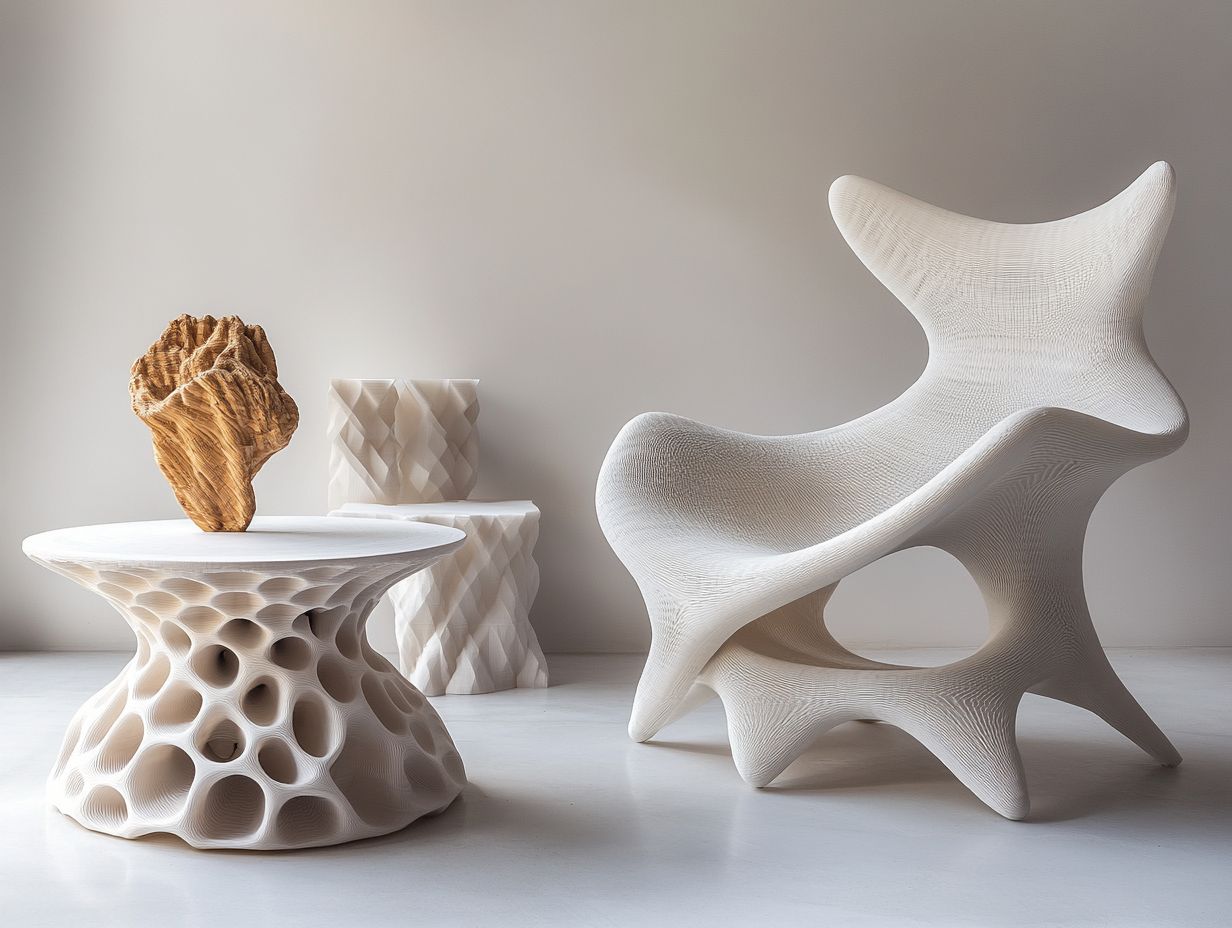
- 1. Create the perfect seating experience with a customizable 3D-printed chair that fits your body’s unique shape and size.
- 2. Keep your devices charged and your space clutter-free with a 3D-printed table that features built-in wireless charging capabilities.
- 3. Maximize your storage space with a 3D-printed bookshelf that can be easily expanded or contracted to fit your needs.
1. 3D-Printed Chair That Can Be Customized to Fit Your Body
The 3D-printed chair marks a remarkable leap in furniture design. It offers customizations that cater to your individual body shape, seamlessly blending artistry with cutting-edge 3D printing technology. For more insights on this innovation, check out how to style your space with 3D-printed furniture, which draws inspiration from diverse applications of 3D printing across various industries, such as Local Motors’ printed cars and even 3D-printed office buildings.
By harnessing advanced software and scanning techniques, you can achieve personalization that traditional manufacturing methods simply can’t match. This chair not only provides features that make sitting more comfortable but also embodies your unique style.
As 3D printing continues to advance, it revitalizes discussions around customization across multiple fields, igniting creativity and challenging the limits of what can be created ranging from intricate urban structures to eco-efficient vehicles. Such versatility underscores the potential of 3D printing technology to revolutionize how you interact with your environment.
2. 3D-Printed Table with Built-In Wireless Charging
A 3D-printed table with built-in wireless charging perfectly embodies the fusion of modern design and technology, elevating both functionality and convenience in your everyday living spaces.
This innovative furniture piece isn t just a stylish centerpiece; it integrates seamlessly into your tech-savvy lifestyle, allowing you to power your devices without the hassle of tangled cables. The advanced materials used in 3D printing think durable thermoplastics and eco-friendly biocomposites enable you to customize designs that align with your aesthetic preferences while ensuring structural integrity.
With a few handy mini power tools, you can take this unique table customization a step further. Incorporate specific features or tweaks that reflect your personal style. This transforms each piece from a mere functional item into a true work of art.
3. 3D-Printed Bookshelf That Can Be Expanded or Contracted
The innovative 3D-printed bookshelf you encounter is a testament to the adaptability of modern furniture design, seamlessly merging aesthetic appeal with practical functionality through methods that build items layer by layer.
This design principle underscores the importance of utility while catering to your desire for personalization in today s living spaces. With 3D printing technology, you can revel in tailored solutions that align with your individual tastes and spatial needs. The ability to customize dimensions, colors, and styles enables a truly one-of-a-kind addition to your home decor.
Hybrid manufacturing combines traditional craftsmanship with 3D printing. This approach not only enhances durability but also allows for intricate designs that were once challenging to realize, bringing together artistry and functionality in the world of furniture solutions.
4. 3D-Printed Lamp with Interchangeable Designs
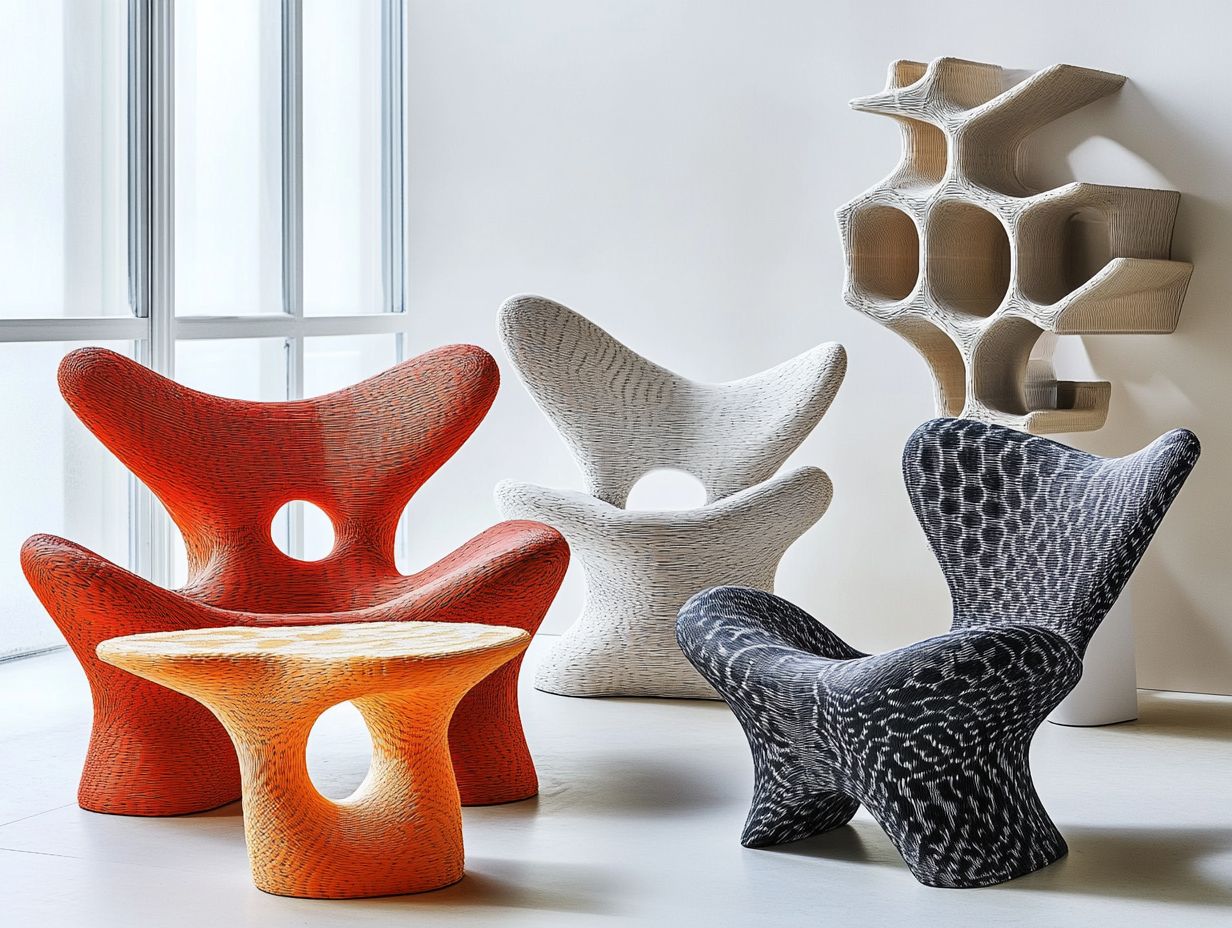
A 3D-printed lamp with interchangeable designs perfectly illustrates the creative possibilities of 3D printing. You can effortlessly switch styles based on your mood or d cor.
This flexibility boosts your personal expression and showcases the amazing technology behind the design process, giving you the power to manipulate shapes and textures with remarkable precision.
The use of robot grippers during assembly enhances efficiency, ensuring that each component is precisely placed without sacrificing quality. As a result, the aesthetic allure of customizable lighting transcends mere functionality, transforming any space into a true reflection of your unique taste and imagination.
5. 3D-Printed Planters That Can Be Hung or Stacked
3D-printed planters that can be hung or stacked transform the way you garden and elevate the style of any space. They showcase the remarkable versatility of 3D printing technology in everyday items.
These one-of-a-kind planters provide design flexibility like no other. You can create customized shapes and sizes that traditional clay or plastic options simply can’t compete with.
Fashioned from sustainable materials, these planters help you minimize your environmental footprint while maintaining a chic aesthetic. This technology is also used in larger projects, where similar techniques are employed to construct impressive structures like life-sized castles.
Unlike conventional gardening solutions that often depend on mass-produced products, 3D-printed options give you a personal touch, turning gardening into a stunning art form that seamlessly integrates into your modern living spaces.
What Is 3D Printing and How Does It Work?
3D printing, often referred to as additive manufacturing (which means building objects layer by layer), is a groundbreaking technology that constructs three-dimensional objects from a digital model. It’s making waves across various sectors, including automotive and healthcare, where complex items like crash test dummies are crafted using sophisticated 3D printers.
It all starts with your digital design, which is meticulously sliced into thin horizontal layers by specialized software. Depending on your specific needs, you can choose from a variety of materials, including plastics, metals, ceramics, and even biological tissues.
This technology offers endless applications, whether you’re creating intricate prototypes for the aerospace industry or producing tailored prosthetics in medical settings. With significant advancements in research and development, the versatility of 3D printing is becoming increasingly clear. It enhances production efficiency while minimizing waste.
What Materials Can Be Used for 3D Printing Furniture?
You can explore a variety of materials for 3D printing furniture, ranging from thermoplastics to metals. Each offers unique properties and advantages that lend themselves to durable and aesthetically pleasing designs.
Take polylactic acid (PLA), for example. It shines when it comes to crafting intricate designs while remaining environmentally friendly, much like its role in 3D-printed components for prototyping across various industries.
On the other hand, acrylonitrile butadiene styrene (ABS) is your go-to for a robust, impact-resistant choice. Its durability makes it perfect for sturdier furniture pieces, echoing its application in automotive parts.
Metal composites are also gaining popularity in furniture creation, not to mention their impressive use in crafting lightweight, high-strength car components. Using materials across industries shows how innovative 3D printing can be, reshaping how you think about both furniture design and manufacturing processes across multiple sectors.
What Are the Advantages of 3D-Printed Furniture?

The advantages of 3D-printed furniture are truly remarkable. They offer a wealth of customization options, including ways to personalize your 3D-printed furniture, that cater to your individual needs while embracing sustainable manufacturing processes that minimize waste.
This innovation resonates with the creative spirit you might admire in artists like Vincent van Gogh.
These benefits go beyond mere aesthetics; exploring the world of 3D-printed furniture design allows for pieces that can be expertly tailored to fit your specific spaces and preferences. It showcases unique shapes and designs that traditional methods simply can’t replicate.
The reduced production time is another game-changer, enabling you to bring designs to life more quickly especially beneficial for businesses aiming to stay ahead of market trends.
When you combine hybrid manufacturing techniques, melding 3D printing with traditional methods, the efficiency of production can soar. This allows for both intricate designs and robust quality.
Imagine using metal 3D printing for structural elements while integrating soft, organic materials for seating. This approach can yield functional yet visually striking pieces that truly revolutionize contemporary interiors.
What Are the Limitations of 3D-Printed Furniture?
Despite its many advantages, 3D-printed furniture does come with certain limitations that may give you pause.
Durability concerns and potentially high production costs can hinder its widespread adoption compared to more traditional furniture manufacturing methods.
The materials often utilized in 3D printing may not measure up to the strength of hardwood or metal. This raises questions about their long-term stability and usability.
While traditional manufacturing can involve significant initial overheads, bulk production tends to drive costs down substantially for mass production.
3D printing struggles to achieve the same efficiency due to smaller batch runs and a more limited range of materials.
The design intricacies and the need for final touch-ups after printing can introduce unexpected expenses for 3D-printed pieces. This can make them less attractive to budget-conscious consumers who are keen on balancing both quality and affordability.
How Can One Purchase 3D-Printed Furniture?
Dive into a world of unique opportunities with 3D-printed furniture! Purchasing opens up various online platforms and specialized retailers, allowing you to acquire one-of-a-kind pieces that embody the 5 unique benefits of 3D-printed furniture and the latest advancements in 3D printing technology and design.
To kick off your search, consider perusing well-known online marketplaces like Etsy. Here, talented artisans display their innovative furniture creations. You can also delve into websites dedicated to custom designs such as Aibuild. These platforms boast a diverse array of styles, ensuring you ll discover something that perfectly aligns with your aesthetic vision.
Additionally, attending local craft fairs or design expos can connect you with artisans who specialize in bespoke 3D-printed furniture.
And don t overlook groundbreaking firms like Local Motors, which are pushing boundaries by creating entire vehicles through 3D printing technology, showcasing the transformative potential of this innovative manufacturing method.
Find something special before it s gone!
What Is the Future of 3D-Printed Furniture?
Exciting changes are coming in 3D-printed furniture! Advancements in manufacturing technology and a growing embrace of innovative designs, championed by trailblazers like EOS North America and Andrey Rudenko, are redefining your approach to home decor. Discover the best 3D-printed furniture for eco-conscious living to elevate your space sustainably.
As these technologies become more accessible, countless emerging designers and companies are eager to explore unconventional materials and forms. This evolution opens the door to a level of customization and creativity that was previously out of reach in traditional furniture production.
The integration of artificial intelligence and machine learning into design processes elevates this revolution even further. These technologies allow for high levels of personalization tailored to your preferences.
With sustainable practices taking center stage, the impact of these advancements goes beyond aesthetics. They also influence the environmental footprint of the furniture industry.
In the end, the fusion of cutting-edge technologies and fresh design perspectives might just usher in a new era of functional artistry in your living spaces. Don’t miss out on the incredible possibilities that 3D-printed furniture offers!
Frequently Asked Questions

What are 3D-printed furniture items?
3D-printed furniture items are pieces of furniture created using a 3D printer. This printer can produce three-dimensional objects by layering materials like plastic or metal. These items are unique in design and can be customized to fit specific needs and preferences, offering 5 ways 3D-printed furniture can save you money.
What are the benefits of 3D-printed furniture items?
There are several benefits to 3D-printed furniture items. They are easily customizable, cost-effective, and have a shorter production time compared to traditional furniture. 3D printing also enables intricate and complex designs that may not be possible with conventional manufacturing methods.
How are 3D-printed furniture items created?
3D-printed furniture items are made using a process called additive manufacturing. This means the printer builds the object layer by layer until the desired shape is achieved. First, the design is created with 3D modeling software and then sent to the printer for production.
What are some unique 3D-printed furniture items?
Some unique 3D-printed furniture items include:
- A chair designed to mimic the shape of a human spine.
- A coffee table made from recycled plastic.
- A lamp with a built-in wireless charging pad.
- A bookshelf that can be arranged in different configurations.
- A modular sofa that can be assembled in various ways.
Can 3D-printed furniture items be used for everyday use?
Yes, 3D-printed furniture items are designed to be functional and durable for everyday use. The materials used in the printing process are carefully selected to ensure strength and stability. However, not all 3D-printed furniture items may be suitable for heavy usage.
Are there limitations to 3D-printed furniture items?
Like any manufacturing process, there are limitations to what can be created with 3D printing. The size of the printer and the materials used can affect the size and strength of the furniture item. Additionally, some designs may be more challenging to print, which can impact the overall quality of the final product.

